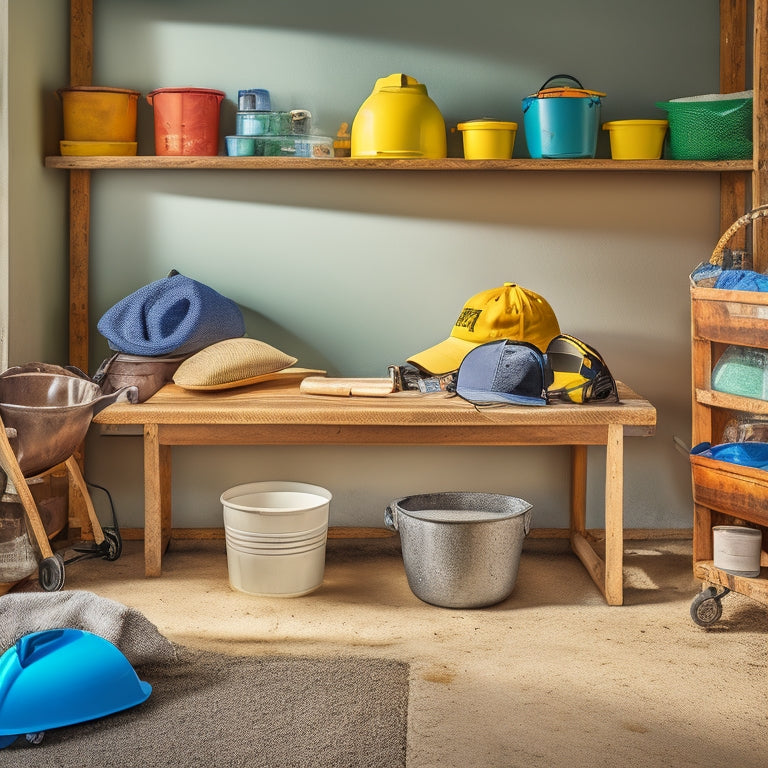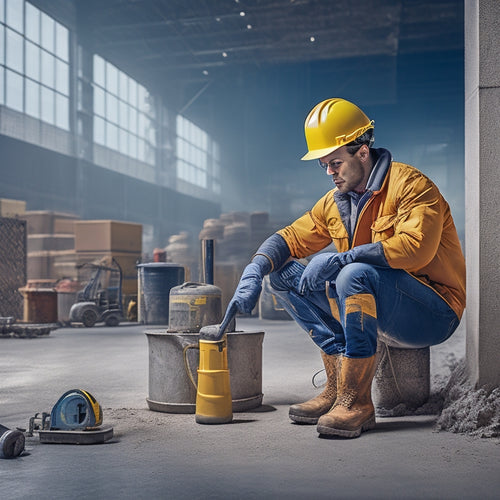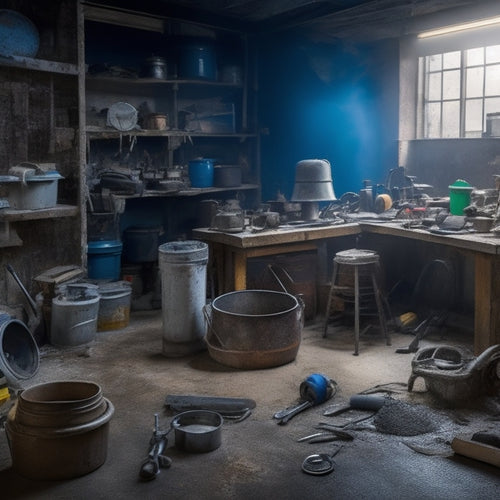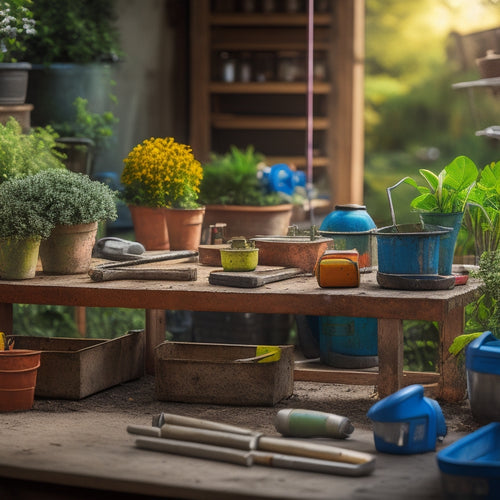
Essential Tools for Efficient Concrete Mixing
Share
When it comes to efficient concrete mixing, you'll need the right tools to get the job done. Start by selecting the ideal concrete mixer for your project, considering factors like mixing capacity, drum speed, and power output. Next, invest in durable mixing paddles made from materials like stainless steel, polyurethane, or rubber, each suited for specific mixing applications. Accurate measuring tools like digital scales and tape measures are also essential for achieving the perfect mix ratio. Additionally, prioritize aggregate handling, water measurement, and mixing drum maintenance to guarantee consistent and high-quality concrete mixes - and that's just the beginning of the essential tools and techniques you'll need to master.
Key Takeaways
• Mixing paddles made of durable materials like stainless steel, polyurethane, or rubber are essential for efficient concrete mixing.
• Accurate measuring tools, including tape measures and digital scales, ensure consistent and precise mix ratios.
• Reliable equipment for transporting, storing, and dispensing aggregates is critical for efficient concrete mixing operations.
• Calibrated water measurement devices and monitoring of water temperature ensure optimal mixing conditions.
• Regular maintenance and inspection of the mixing drum, as well as proper storage techniques, prolong equipment lifespan and improve performance.
Concrete Mixer Selection Guide
How do you choose the right concrete mixer for your project when faced with a multitude of options, each boasting unique features and capabilities?
With so many mixer types available, it's crucial to understand their differences and performance capabilities to guarantee you select the right one for your specific needs.
When comparing mixers, consider the type of project you're working on, the quantity of concrete needed, and the desired mixing speed. Drum mixers, for instance, are ideal for large-scale projects that require high-volume mixing, while pan mixers are better suited for smaller batches and more precise control. Twin-shaft mixers, on the other hand, offer high-intensity mixing for demanding applications.
Performance comparison is critical in selecting the right mixer. Look for features like mixing capacity, drum speed, and power output.
Additionally, consider the mixer's safety features, such as emergency stops, safety grills, and operator protection systems. By evaluating these factors, you can make an informed decision and choose a mixer that meets your project's requirements, guaranteeing efficient and safe concrete mixing.
Essential Mixing Paddle Options
As you've selected the right concrete mixer for your project, it's now time to focus on the mixing paddles that will guarantee efficient and effective mixing of your concrete. The right paddle can make all the difference in achieving a consistent mix, and it's important to choose a paddle that suits your specific needs.
When it comes to paddle materials, you'll want to take into account options that are durable, resistant to wear and tear, and easy to clean. Stainless steel, polyurethane, and rubber are popular choices, each with their own strengths and weaknesses. Stainless steel paddles are ideal for heavy-duty mixing, while polyurethane paddles offer flexibility and resistance to abrasion. Rubber paddles, on the other hand, are gentle on the mixer and ideal for smaller batches.
Paddle shapes are also significant, as they affect the mixing pattern and efficiency. You'll want to choose a paddle shape that complements your mixer's design and the type of concrete you're working with. Flat paddles are great for scraping the sides and bottom of the mixer, while curved paddles are better suited for mixing thick, heavy concrete.
Measuring Tools for Accuracy
With accurate measurements being essential to achieving the right concrete mix, you'll need to equip yourself with reliable measuring tools that guarantee precision and consistency.
A tape measure is a must-have for measuring the dimensions of your mixing area, containers, and tools. Make sure it's sturdy, waterproof, and has clear markings to avoid errors.
When it comes to measuring ingredients, a digital scale is a game-changer. It provides accurate weight readings, allowing you to achieve the perfect mix ratio. Look for a scale with high precision (at least 0.1 oz or 1 g) and a large weighing capacity to accommodate different batch sizes. Additionally, consider a scale with a compact design and easy-to-clean surface to minimize contamination risks.
Aggregate Handling Made Easy
You'll need a reliable system for handling and managing aggregates, such as gravel, sand, and crushed stone, to guarantee efficient concrete mixing and minimize material waste. This is where aggregate handling equipment comes in. With the right tools, you'll be able to efficiently transport, store, and dispense different aggregate types, ensuring a smooth mixing process.
When selecting handling equipment, consider the specific aggregate types you'll be working with. For instance, coarse aggregates like gravel and crushed stone require sturdy conveyors and bins, while fine aggregates like sand may require more delicate handling. Look for equipment designed with safety features, such as dust suppression systems and emergency shut-off mechanisms, to protect yourself and your team from potential hazards.
Investing in high-quality aggregate handling equipment won't only streamline your concrete mixing process but also reduce the risk of accidents and material contamination. By implementing an efficient aggregate management system, you'll be able to produce high-quality concrete while maintaining a safe and organized workspace.
Water Measurement Essentials
When you're mixing concrete, you know that getting the water measurement just right is essential.
You need to guarantee you're using the correct water ratio to achieve the desired consistency and strength, and that's where accurate water measurement comes in.
Accurate Water Ratios
Achieving an ideal concrete mix relies on precise water measurement, as even slight deviations from the recommended water-to-cement ratio can greatly impact the final product's strength, workability, and durability. You can't afford to guess or eyeball the water amount, as this can lead to inconsistent results and compromised safety.
To guarantee accurate water ratios, you need to take into account the type of cement, aggregate, and additives used in your mix. Additionally, you must account for water absorption rates of the aggregates, as excessive water can lead to weak and porous concrete.
When measuring water, you should aim for a consistent mixing consistency. This can be achieved by using a calibrated measuring device, such as a digital scale or a graduated cylinder. Always follow the recommended mixing procedure and avoid over- or under-mixing, which can also affect the final product's quality.
Optimal Water Temperature
As you measure water for concrete mixing, remember that accurate water measurement extends beyond volume to encompass temperature, as water that's too hot or cold can greatly impact concrete's setting time, strength, and overall quality.
You're aiming for ideal mixing conditions, and water temperature plays a vital role in achieving them. Water temperature effects can be significant: temperatures above 70°F (21°C) can accelerate setting, while temperatures below 50°F (10°C) can slow it down. This, in turn, affects concrete's strength and durability.
To guarantee ideal mixing conditions, you should aim for a water temperature between 50°F (10°C) and 70°F (21°C). This range allows for a suitable setting time and helps prevent excessive heat generation, which can lead to concrete defects.
When mixing concrete, monitoring water temperature is critical to avoid deviations from this ideal range. By doing so, you'll be able to create a high-quality concrete mix that meets your project's requirements.
Mixing Drum Maintenance Tips
As you work to maintain ideal mixing performance, you'll want to prioritize regular maintenance of your mixing drum.
You'll need to establish a routine that covers drum cleaning best practices, regular inspection schedules, and proper storage techniques to prevent damage and guarantee longevity.
Drum Cleaning Best Practices
You must thoroughly clean your mixing drum after each use to prevent residual concrete from hardening and reducing the drum's capacity. This is essential to maintain the drum's performance and extend its lifespan.
For effective cleaning, use a combination of pressure washing and cleaning solutions specifically designed for concrete removal. The frequency of cleaning depends on the usage of the drum, but as a general rule, clean the drum daily or after every 5-6 batches of concrete mixed.
When cleaning, focus on the drum's interior, including the sides, bottom, and discharge chute. Remove any stubborn concrete residue using a stiff-bristled brush or a scraper.
Be certain you wear protective gear, including gloves, safety glasses, and a face mask, to prevent exposure to harsh cleaning agents and concrete dust.
Regular drum cleaning also helps prevent corrosion and reduces the risk of contamination, which can affect the quality of your concrete mix.
Regular Inspection Schedules
Regularly, every 1-3 months, inspect your mixing drum for signs of wear and tear to catch potential issues before they escalate into costly repairs. This inspection frequency allows you to identify and address minor problems before they become major ones, reducing downtime and saving you money in the long run.
By incorporating regular inspections into your maintenance routine, you'll reap several benefits, including extended equipment lifespan, improved mixing performance, and enhanced operator safety.
During each inspection, pay attention to signs of wear on the drum's interior and exterior surfaces, as well as the condition of the blades, bearings, and seals. Look for any cracks, corrosion, or excessive wear, and address these issues promptly.
Proper Storage Techniques
When not in use, store your mixing drum in a clean, dry area to prevent corrosion and contamination, guaranteeing it remains in prime condition for the next mixing operation.
You should also consider investing in storage containers specifically designed for mixing drums, which provide an additional layer of protection against environmental factors. These containers are typically made of durable materials and are equipped with humidity control systems, maintaining a stable environment that prevents moisture buildup.
Regularly cleaning and drying your mixing drum before storage will also help prevent rust and corrosion. Additionally, make sure to follow the manufacturer's storage guidelines and recommendations for maintenance to guarantee the longevity of your mixing drum.
By implementing these proper storage techniques, you'll be able to extend the lifespan of your mixing drum, reduce downtime, and maintain a safe working environment.
Power Trowel Selection Criteria
Selecting the right power trowel for concrete mixing involves evaluating several critical factors, including blade type, engine power, and handle ergonomics. You'll want to take into account the type of concrete you're working with, the size of the area you need to cover, and the level of finish you're aiming for.
Here's a breakdown of key considerations for power trowel selection:
| Power Trowel Type | Trowel Blade Materials | Recommended Use |
|---|---|---|
| Walk-behind | Steel or polyurethane | Large areas, high-traffic zones |
| Ride-on | Steel or polyurethane | Very large areas, commercial projects |
| Edger | Steel or aluminum | Edging, finishing, and detail work |
| Float | Aluminum or magnesium | Smoothing, flattening, and leveling |
| Finishing | Stainless steel or chrome | High-gloss finishes, decorative work |
When choosing a power trowel, prioritize safety features like ergonomic handles, adjustable speed controls, and protective guards. Additionally, make sure you have the necessary protective gear, including gloves, safety glasses, and a dust mask. By taking these factors into account and selecting the right power trowel for your specific needs, you'll be well on your way to achieving a smooth, even finish.
Finishing Tools for Smooth Finish
You'll need to switch to finishing tools once you've achieved a solid base with your power trowel, as these specialized tools are designed to refine the surface and produce a smooth, high-quality finish. This is where you'll focus on perfecting your finishing techniques to achieve the desired outcome.
For a smooth finish, you'll require a range of finishing tools, including edgers, floats, and tamping tools.
Edgers are used to create a crisp, clean edge along walls, columns, and other areas where the concrete meets other surfaces. Floats, on the other hand, help to remove any imperfections and even out the surface. Tamping tools, such as bull floats and fresno trowels, are used to compact and flatten the concrete, ensuring a solid, even base.
Proper surface preparation is essential at this stage, as it sets the stage for a high-quality finish. By selecting the right finishing tools and mastering the necessary techniques, you'll be able to achieve a smooth, professional-looking finish that meets your expectations.
Safety Gear for Mixing Concrete
As you begin mixing concrete, donning the right safety gear is essential to protecting yourself from the hazardous materials and processes involved. Mixing concrete can be a hazardous activity, and without proper personal protective equipment (PPE), you're at risk of serious injury or illness.
To guarantee mixing site safety, make sure you have the following essential safety gear:
-
Hard hat or safety helmet: protects your head from falling objects or debris
-
Safety glasses or goggles: shields your eyes from cement dust, flying particles, and chemical splashes
-
Dust mask or respirator: filters out airborne particles and prevents inhalation of hazardous materials
-
Gloves: protects your hands from abrasive materials, cuts, and chemical exposure
-
Steel-toed boots or shoes: prevents foot injuries from heavy objects or tools
Efficient Mixing Techniques
Your mixing technique plays a critical role in achieving a consistent, high-quality concrete mix. As you operate the mixer, you'll want to maintain a steady mixing speed to guarantee all materials are well incorporated. Aim for a speed that's fast enough to mix the ingredients thoroughly, but slow enough to prevent segregation and aeration.
To attain ideal material consistency, it's crucial to add ingredients in the correct order and at the right time. Start by adding the dry materials, such as cement and aggregates, to the mixer. Then, gradually add water while continuing to mix. This helps to prevent lumps from forming and guarantees a uniform consistency.
As you mix, pay attention to the concrete's slump and flow. A well-mixed concrete should have a smooth, even texture and a consistent color. If you notice any signs of segregation, such as uneven color or texture, stop the mixer and re-mix the concrete.
Frequently Asked Questions
Can I Reuse Concrete Mixing Paddles With Different Mix Designs?
When you're working with different concrete mix designs, you're right to wonder if you can reuse your mixing paddles.
The answer is, it depends. Mixing paddle compatibility is essential, as residue from previous mixes can contaminate new batches.
If you're switching between similar concrete mix variations, you might be okay.
But if you're jumping between vastly different mixes, it's best to use a dedicated paddle to guarantee safety and prevent unwanted chemical reactions.
Better safe than sorry!
How Often Should I Clean My Concrete Mixing Drums?
When it comes to drum maintenance, you'll want to establish a regular cleaning frequency to guarantee peak performance and safety.
You should clean your concrete mixing drums after every 5-10 uses, or at the end of each workday, whichever comes first.
This prevents the buildup of residual concrete, reduces the risk of contamination, and maintains the drum's structural integrity.
Are There Specific Safety Gears for Mixing Colored Concrete?
As you step into the world of colored concrete mixing, you're about to release a vibrant storm of pigments.
But, before you do, take a deep breath and prioritize your safety. You'll need more than just a sturdy drum to protect yourself.
Are you prepared to shield your eyes from the swirling clouds of powder? Don't forget your safety goggles.
And what about the toxic fumes? A respirator mask is a must-have to safeguard your lungs.
Can I Use a Power Trowel on Freshly Poured Concrete?
When you're working with fresh concrete, you're likely wondering if you can use a power trowel on it. The answer is yes, but with caution.
A power trowel can be beneficial for achieving a smooth finish, but it's essential to wait until the concrete has reached the initial set stage. This is typically around 2-4 hours, depending on the mix design and ambient conditions.
Using a power trowel too early can compromise the concrete's integrity, so be patient and follow fresh concrete techniques to guarantee a successful outcome.
Do I Need a Permit to Mix Concrete on a Residential Property?
As you stand on your residential property, surrounded by the sweet scent of freshly poured concrete, you wonder: do you need a permit to mix concrete?
The answer is, it depends on your local residential regulations.
In some areas, mixing permits are required for large-scale projects or those that impact environmental or public health.
You'll need to check with your local authorities to determine if a permit is necessary, ensuring you're in compliance and avoiding costly fines.
Conclusion
With concrete mixing mastery within your grasp, you've crafted a cake walk to completion.
Carefully chosen concrete mixers, precision paddles, and accurate measuring tools align like puzzle pieces, paving the path to perfection.
By incorporating efficient aggregate handling, precise water measurement, and power trowel proficiency, you've primed your project for a polished finish.
Finally, don safety gear and fine-tune your finishing techniques to flaunt a flawless fusion of form and function.
Related Posts
-

10 Best Tools for Sealed Concrete Flooring on Budget
When starting on a sealed concrete flooring project on a budget, you'll need to prioritize essential tools without sa...
-

7 Tools to Fix Damaged Concrete Floors
You're about to tackle that damaged concrete floor, and the right tools are essential for a successful repair. Start ...
-

Must-Have Tools for Concrete Planter Projects
As you commence your concrete planter project, you'll need a range of specialized tools to achieve professional-grade...


